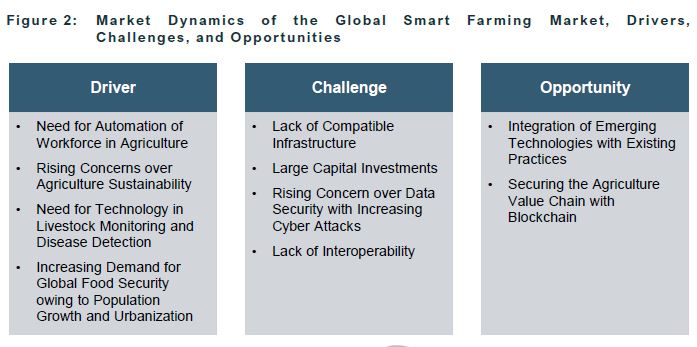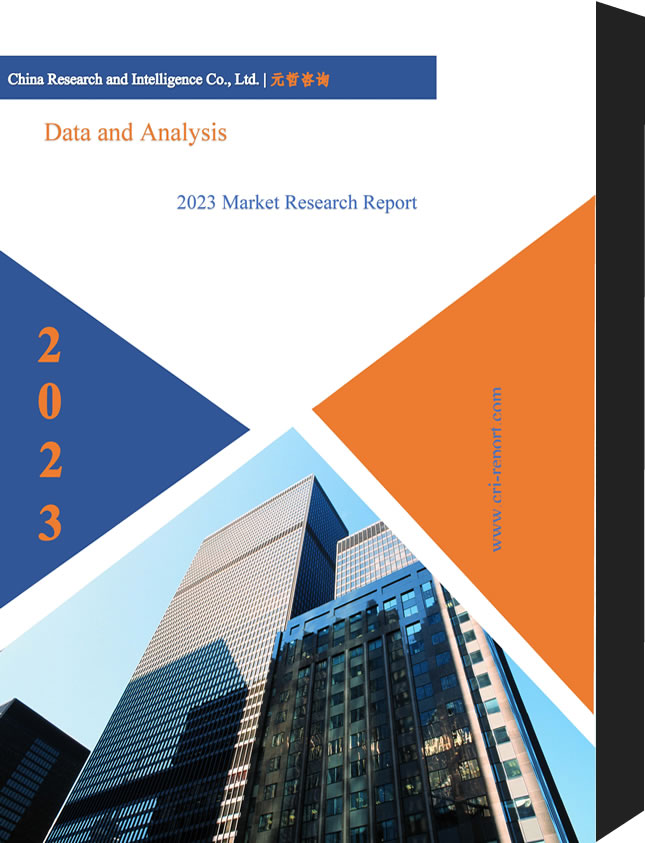Description
Global Smart Farming Market Industry Overview
The global smart farming market was valued at $15.06 billion in 2022 and is expected to reach $33.0 billion in 2027, following a CAGR of 16.99% during 2022-2027. The growth in the global smart farming market is expected to be driven by increase in adoption of IoT and artificial intelligence, digitalization of agriculture operations, rise in dependence on advanced technologies to enhance production across the globe.
Market Lifecycle Stage
The smart farming market is in a growing phase owing to different advanced technologies in the market. As increase in adoption of automated machineries and equipment, sensors and navigation systems, robots, autonomous vehicles, and others. Sensor is the most important hardware component used in the modern agriculture operations.
Impact
• Smart farming is about using the new technologies that emerged in agriculture and livestock at the beginning of the fourth industrial revolution to increase production volume and quality by making maximum use of resources and minimizing environmental impact. Also, the implementation of technology in agriculture and livestock will make it possible to improve food security around the world.
• The use of smart farming technologies has positive impact of agriculture operations and livestock farming. These technologies offer benefits such as increased efficiency & productivity, water saving, reduced costs, pest detection and animal health, better sustainability, and others. In addition, smart farming helps farmers better understand the important factors such as water, topography, orientation, vegetation and soil types.
Impact of COVID-19
Due to the COVID-19 pandemic, the research & development has slowed down owing to the lack of funding, halt manufacturing activities, and components or raw material supply chain disruptions. In addition, positive impact of COVID-19 had been seen on smart farming technologies adoption such as autonomous vehicles, robots, software solutions, and sensors by farmers owing to lack of workers which is resulted in increase in demand for smart farming solutions worldwide.
Market Segmentation:
Segmentation 1: by Application
• Precision Farming
• Livestock Monitoring and Management
• Aquaculture
• Others
The global smart farming market in the application segment is expected to be dominated by precision farming applications. Rise in use of precision farming applications such as precision irrigation, yield monitoring & forecasting, precision spraying, precision planting, and others are expected to drive the growth of this segment globally. This is followed by the livestock monitoring and management segment which accounts for the second-largest share in the smart farming market due to increase in awareness and demand towards tracking and monitoring of health of livestock across the globe.
Segmentation 2: by Product Type
• Hardware
• Software
The hardware segment is estimated to capture highest market share during the period 2022 to 2027. The hardware equipment is increasingly used in the various farming operations. In addition, the increasing adoption of intelligent or autonomous vehicles integrated with sensors and navigation systems, computer vision is expected to drive the growth of the smart farming market worldwide. Moreover, increase in penetration of integrated hardware and software technologies are expected to increase the production and efficiency of farms which in turn is projected to drive the market growth in the coming years.
Segmentation 3: by Region
• North America – U.S., Canada, and Mexico
• Europe – Germany, France, Italy, Spain, Netherlands, Greece, Ukraine, Belgium, Switzerland, and Rest-of-Europe
• China
• U.K.
• Asia-Pacific – India, Japan, Australia and New Zealand, Thailand, South Korea, and Rest-of-Asia-Pacific
• Middle East and Africa – Israel, South Africa, Turkey, and Rest-of-Middle East and Africa
• South America – Brazil, Rest-of-South America
North America dominated the smart farming market in 2021 and is anticipated to uphold its dominance throughout the forecast period. The growth in the market is majorly driven by the increasing research and development activities and large-scale adoption of digital technologies.
Recent Developments in Global Smart Farming Market
• In January 2022, Hexagon Agriculture launched a new technology named HxGN AgrOn planting assistant. This new technology is aimed at improving accuracy in shovel planting. This item can also be adopted by other types of crops, such as palm oil, coffee, banana, and citrus.
• In October 2022, Trimble Inc. launched new agriculture displays, such as Trimble GFX-1060 and GFX-1260, for precision agriculture applications. These displays provide next-generation performance and connectivity for in-field operations.
• In June 2022, BASF acquired Horta S.r.l., an Italian company specialized in digital farming solutions. Horta is an established player for the development of highly innovative agronomic Decision Support Systems (DSS) for crops such as grapes, tomatoes, cereals and olives.
• In August 2022, CropX inc. launched a continuous nitrogen leaching monitoring capability for its farm management system. This new development would track the nitrogen movement and salts in the soil.
Demand – Drivers and Limitations
Following are the demand drivers for the Smart Farming Market:
• Need for Automation of Work Force in Agriculture
• Rising Concerns over Agriculture Sustainability
• Need For Technology in Livestock Monitoring and Disease Detection
• Increasing Demand for Global Food Security owing to Population Growth and Urbanization

The market is expected to face some following challenges:
• Rising Concern over Data Security with Increasing Cyber Attacks
• Lack of Compatible Infrastructure
How This Report Can Add Value to End Users
Product/Innovation Strategy: The product segment helps the reader understand the different types of hardware and software is expected to available for deployment in the smart farming applications. Moreover, the study provides the reader a detailed understanding of the different product types by applications (precision farming, livestock monitoring & management, aquaculture, and others). Hardware solutions such as autonomous vehicles, sensing and navigation systems, yield mapping devices, and auto steering systems are most widely used in modern agriculture practices. Therefore, the smart farming market is a moderate investment and high revenue generating product in the coming years owing to the rise in investment towards climate smart agriculture practices across the globe.
Growth/Marketing Strategy: The global smart farming market has seen major development by key players operating in the market, such as acquisition, partnership, agreement, business expansion, and product launches. The favoured strategy for the companies has been agreement, business expansion, and product launch to strengthen their positions in the smart farming market.
For instance, in August 2021, Deere & Company acquired Bear Flag Robotics; an agriculture technology startup based in Silicon Valley. Bear Flag’s technology enables a machine to work in a field autonomously. Bear Flag’s technology complements Deere’s technology initiatives and goals to help farmers achieve the best possible outcomes and solve meaningful challenges through advanced technology, including autonomy.
Competitive Strategy: Key players in the global Smart Farming Market analysed and profiled in the study involve integrated hardware and software manufacturers that are engaged in providing advanced smart farming solutions to farmers and other agriculture service companies. Moreover, a detailed competitive benchmarking of the players operating in the global Smart Farming Market has been done to help the reader understand how players stack against each other, presenting a clear market landscape. Additionally, comprehensive competitive strategies such as partnerships, agreements, acquisitions, and collaborations will aid the reader in understanding the untapped revenue pockets in the market.
Key Market Players and Competition Synopsis
The companies that are profiled have been selected based on inputs gathered from primary experts and analysing the company’s coverage, product portfolio, its market penetration.
The top segment players who are leading include key precision farming and livestock monitoring & management technologies manufacturers in the market and the ones which are engaged in providing smart aquaculture solutions across the globe.
Key Companies Profiled
Company Type 1: Precision Farming and Farm Management
• Ag Leader Technology
• AGCO Corporation
• CNH Industrial N.V.
• Deere & Company
• Hexagon Agriculture
• Kubota Corporation
• Climate LLC
• Trimble Inc.
• BASF SE
• CropX inc.
• Connecterra B.V.
• Naio Technologies
• DJI
• Signify Holding
• Osram Licht AG
Company Type 2: Livestock Monitoring and Management
• Afimilk Ltd.
• Allflex USA Inc.
• Nedap N.V.
• Cargill, Incorporated
• GEA Group Ag
Company Type 3: Aquaculture
• AKVA Group ASA
• Eruvaka Technologies
• AquaManager
Related Reports
Related Report: Global Indoor Farming Technology Market – A Global and Regional Analysis: Focus on Key Technologies, Patents, Drivers, Opportunities, Challenges, and Applications
Related Report: Smart Farming Market – A Europe Region Analysis – Focus on Application, Product, and Country-Wise Analysis – Analysis and Forecast, 2022-2027


